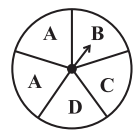NCERT Solutions for Class 8 Maths Chapter 4 - Data Handling - 2 (Exercise 4.2)
Exercise 4.2
Q1. List the outcomes you can see in these experiments.
(a) Spinning a wheel
(b) Tossing two coins together

Ans: (a) Outcomes is spinning the given wheel are: A, B, C or D.
(b) Outcomes in tossing two coins together are: HT, HH, TH, TT
[where HT → Head on first coin + Tail on second coin and so on]
Q2. When a die is thrown, list the outcomes of an event of getting
(i) (a) a prime number (b) not a prime number
(ii) (a) a number greater than 5 (b) a number not greater than 5.
Ans: Possible outcomes are: 1, 2, 3, 4, 5 or 6.
Out of them prime numbers are 2, 3 and 5.
(i) (a) Outcomes of getting a prime number are: 2, 3 or 5.
(b) Outcomes of getting not a prime number are: 1, 4 or 6
(ii) (a) Outcome of getting a number greater than 5 is 6.
(b) Outcomes of getting a number not greater than 5 are: 1, 2, 3, 4 or 5.
Q3. Find:
(a) Probability of the pointer stopping on D in (Question 1-(a))?
(b) Probability of getting an ace from a well shuffled deck of 52 playing cards?
(c) Probability of getting a red apple. (See figure below)
Ans: (a) On the spinning wheel there are 5 sectors containing A, B, C and D.
Since, there is only 1 sector containing D.
i.e. possible outcome = 1
Number of equally likely outcomes = 5
∴ Probability = 1/5
(b) Number of possible outcomes = 52
Since, there are 4 aces in a pack of 52 cards, and out of them one ace can be obtained in 4 ways.
∴ Equally likely outcomes = 4
∴ Probability of getting an ace = 4/52 = 1/13
(c) There are 7 apples in all
∴ Possible number of ways = 7
Since, there are 4 red apples: Therefore, a red apple can be obtained in 4 ways.
i.e. Equally likely outcome = 4
∴ Probability of getting a red apple = 4/7
Q4. Numbers 1 to 10 are written on ten separate slips (one number on one slip), kept in a box and mixed well. One slip is chosen from the box without looking into it. What is the probability of .
(i) getting a number 6?
(ii) Getting a number less than 6?
(iii) Getting a number greater than 6?
(iv) Getting a 1-digit number?
Ans: Since, there are 10 slips. At a time any slip can be taken out.
∴ Number of total outcomes = 10
Now,
(i) We can get a slip containing the number ‘6’ only once.
∴ Number of favourable outcome = 1
Thus, probability of getting the number 6 = 1/10
(ii) There are five numbers (i.e. 1, 2, 3, 4 and 5) which are less than 6.
∴ Favourable outcomes are 5.
Thus, Probability of getting a number less than six = 5/10 = 1/2
(iii) There are 4 numbers (i.e. 7, 8, 9, 10) which are greater than six.
∴ Favorable outcomes = 4
Thus, probability of getting a number greater than six = 4/10 = 2/5
(iv) There nine one-digit numbers i.e. (1, 2, 3, 4, 5, 6, 7, 8 and 9)
∴ Favorable outcomes = 9
Thus, probability of getting a one-digit number = 9/10
Q5. If you have a spinning wheel with 3 green sectors, 1 blue sector and 1 red sector, what is the probability of getting a green sector? What is the probability of getting a non blue sector
Ans: There are 5 sectors in all (3 green + 1 blue + 1 red).
∴ There are total possible outcomes = 5.
Since, there are 3 green sectors.
i.e. Number of favourable outcomes = 3
Thus, probability of getting a green sector = 3/5
Again, there are 4 non-blue sectors
∴ Favouable outcomes = 4
Thus, probability of getting a ‘non-blue’ sector = 4/5
Q6. Find the probabilities of the events given in Question 2.
Ans: There are 6 outcomes in all (i.e. 1, 2, 3, 4, 5, 6)
(i) Since, there are 3 prime numbers (i.e. 2, 3, and 5)
∴ Favourable outcomes = 3
Thus, probability of getting a prime number = 3/6 = 1/2
(ii) Since, there are 3 non-prime numbers (i.e. 1, 4 and 6)
∴ Favourable outcomes = 3
Thus, the probability of getting a non-prime number = 3/6 = 1/2
(iii) Since, there is 1 number greater than 5 (i.e. 6)
∴ Favourable outcome = 1
Thus, probability of a number greater than 5 = 1/6
(iv) Since, there are 5 numbers which are not greater than 5 (i.e. 1, 2, 3, 4 and 5)
∴ Number of favourable outcomes = 5
Thus, the probability of a number which is not greater than 5 = 5/6
|
276 docs|155 tests
|






















